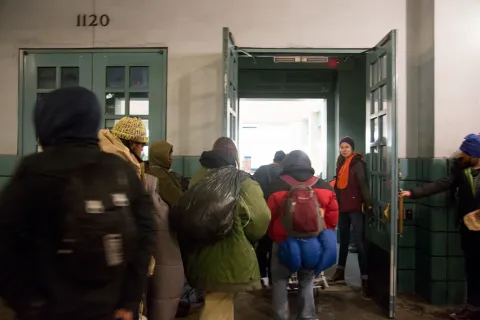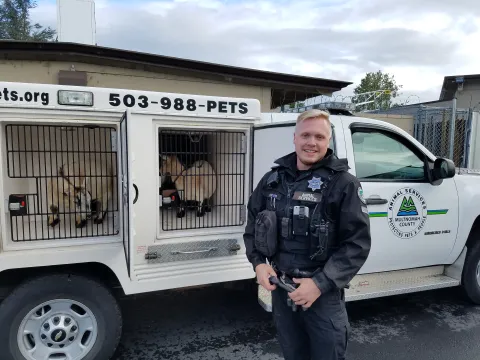
The Operations section DOES things
Basic description: Conducts tactical operations and directs all tactical resources. Depending on the position, some operations staff work in the EOC, others work in the field at Disaster Resource Centers, Points of Dispensing (PODs), Community/Commodity Points of Distribution (C-PODs), or on Perimeters and performing evacuation notifications, etc.
The Operations Section Manager (OSM) is a seasoned leader, knowledgeable regarding County policies, procedures, administrative rules, vision and values, as well as, the County’s emergency response plan. Major attributes include:
- Facilitative leadership
- Excellent practical knowledge and skills in establishing and meeting objectives.
Supervisors and Leaders. Division/Group Supervisors and Team/Task Force Leaders supervise field operations (Disaster Resource Centers, transportation, evacuations, sheltering, etc.) required to meet objectives. They are:
- Results oriented leaders, focused on meeting expectations.
- Able to appropriately care for their staff and motivate them to do what they must.
The Operations Section includes the following Emergency Support Functions (ESFs), which are in operation depending on the type and scale of the incident. How do they work? Each ESF has a team that coordinates that specific function’s activities and needs. For example, ESF-1 anticipates and coordinates transportation needs with partners such as ODOT, PBOT, Trimet, and others. All of the people staffing the ESFs below, need to possess:
- Subject matter expertise in one or more of the following, related: infrastructure, technology, supplies, personnel qualifications, or equipment
- The ability to prioritize scare resources based on life safety, scene stabilization, and property protection
- A basic understanding of the function itself
- Ability to coordinate with governmental, non-governmental, private, non-profit, and other organizations
- ESF-1: Transportation - managing transportation systems, modes, and infrastructure. Think roads, bridges, ports (air and water), and railways
- ESF-2: Communications - Communications and information technology capabilities necessary to support response efforts, facilitate the delivery of information to emergency management decision-makers, and stabilize and re-establish systems and applications
- ESF-3: Public Works -Manage assessments of public works and infrastructure, and performing emergency work to restore critical lifelines and key resources to support life-saving and life-sustaining services. Think levees, water systems, debris management, road clearing, demolition and subsequent removal and disposal of buildings and structures
- ESF-4: Firefighting - Provides support for the detection and suppression of wildland, rural and urban fires resulting from or occurring coincidentally with a large-scale incident.
- ESF-5: See Planning Section
- ESF-6: Mass Care and Human Services - Coordinates the delivery of mass care, emergency assistance, temporary housing and human services. Example of mass care activities include but are not limited to sheltering, feeding, emergency first aid, bulk distribution of emergency items and family reunification.
- Disaster Resource Center (DRC) Staff - view our training videos and take a knowledge test for your initial certification. Read more about how to get involved in DRCs.
- Community/Commodity Points of Distribution (C-PODs)
- ESF-8: Public Health and Medical Services - Behavioral health, disease, and injury prevention, patient movement, fatality management, technical assistance/exposure assessments related to environmental health, health surveillance, medical surge, patient care, food safety, assessment of public health/medical needs, vector control, public health aspects of potable water/wastewater and solid waste disposal, Points of Dispensing (PODs)
- ESF-9: Search and Rescue - Coordinates search and rescue operations and resources in support of water, urban and wilderness search and rescue during actual or potential emergencies.
- ESF-10: Hazardous Materials Response - Coordinates response operations resulting from a threat to public health, welfare or the environment caused by actual or potential oil and hazardous materials incidents. Hazardous materials include chemical, biological, radiological and nuclear substances, whether accidentally or intentionally released.
- ESF-11: Food and Water - Undertakes action to assess food and water requirements within the county in the event of an emergency. These actions include coordinating with other jurisdictions, the Oregon Food Bank, and other government and nonprofit organizations to determine food assistance needs; procuring food and water supplies; and arranging transportation of these supplies to shelters or staging areas within the county.
- ESF-12: Energy - Collects, evaluates and shares information on energy system damage; provides estimations on the effect of energy system outages within the affected area; and coordinates governmental and nongovernmental efforts to establish temporary emergency energy production and transmission capabilities to support critical lifelines and facilities until permanent restoration is accomplished.
- ESF-13: Military Support - Establishes a coordination point between local government and military support capabilities made available through the State of Oregon.
- ESF-14: See Public Information, within the Command Staff.
- ESF-15: Volunteers and Donations - Establishes the coordination processes used to ensure the most efficient and effective utilization of unaffiliated volunteers and unsolicited donated goods during incidents requiring a local response.
ESF-16: Law Enforcement - Coordinates law enforcement personnel and equipment to support emergency response operations. This support function is inclusive of general law enforcement duties, emergency police and public safety services.

- ESF-17: Agriculture and Animal Protection - Provides support for protection of the food supply and addresses issues of plant and animal health, agricultural security, and care and shelter of livestock and other large animals.
- ESF-18: Business and Industry - Describes and implements the policies, responsibilities and concept of operations for county incident management activities involving coordination with the private sector during incidents requiring coordinated response.
Next Steps...
If this or any of the other positions below spark your interest or you’d like to find out more, please fill out our Emergency Operations Center online interest form and we will contact you.
In addition, the following introductory level courses are recommended for all disaster response staff:
- ICS 100: Introduction to the Incident Command System. This is an interactive web based course.
- ICS 700: An Introduction to the National Incident Management System. This is an interactive web based course.
- Deployment - Assignment Basics. This is a County-led training opportunity. Registration for County staff is through Workday.
